#Learning data science topics
Explore tagged Tumblr posts
Text
#Embark on a transformative journey with a Data Science course in Chandigarh#designed for aspiring professionals from Punjab and Haryana. This program offers in-depth knowledge of essential topics#including statistics#machine learning#data visualization#and big data analytics. Participants will engage in hands-on projects and real-world case studies#ensuring practical experience and skill development. Learn to use industry-standard tools and programming languages like Python and R#equipping yourself for a successful career in the rapidly growing field of data science.#SoundCloud
0 notes
Text

Stupid Girl (fondly)
not really sure what this is, but the scott rot was real after watching twisters
Word Count: 1.4k
Summary: Scotts an asshole but he secretly cares (?)
Scott was irritated, although that wasn’t saying much, considering he usually was. The heat and lack of data they’d collected due to Javi following Kate around had him more on edge than usual. It didn’t help that you had been ignoring him.
There’s no way he would ever admit to the fact, but he missed you. He knew he’d messed up earlier, and you were usually more forgiving of his moods, but the heat seemed to have you on edge too.
Thinking about it now, you’re surprised the two of you hadn’t gotten into such a fight before this, considering the difference in your jobs. Scott profited off the tornado victims, and you offered your services for free.
During the calmer seasons, you worked as a nurse in a nearby clinic, and during tornado season, you normally frequented the towns with the most wreckage and helped the victims in any way you could.
Scott and you had met in a similar way, actually. He had been in one of the town’s aftermaths to help his uncle with marketing for Storm Par when he saw you. You were treating a small scrape on a kid no older than 10. Scott had rolled his eyes when he saw the kid’s tears. It was a scrape, and here you were doting on him like it was a gash. Once the kid had run off to find his mother, Scott approached you. Once he got closer, he noted you were… pretty. Not that he cared, obviously.
“He was fine,” Scott scoffed, almost annoyed.
You had been confused at first, mumbling, “Sorry?” as you stood to brush yourself off from where you had been crouching next to the boy.
“He’s gonna complain about a paper cut if he gets coddled like that,” he smacked his gum.
“He’s a kid. Plus, paper cuts hurt,” you countered, raising your head to look at him.
And not to be dramatic, but he was gorgeous. Maybe that’s why you ignored the obvious asshole demeanor he had.
Scott rolled his eyes. “He’s a wuss,” and he fought a smile at the offended look you had at his words.
You glared at him and almost argued, but decided he wasn’t worth your time. No matter how gorgeous.
Scott, unfortunately for him, could not say the same.
“I’m Scott,” he said, even reaching out his hand. Not because he wanted to feel your hand or anything; he was doing it to be polite. At least, that’s what he told himself.
You rolled your eyes, but it was more lighthearted than anything, and told him your name, reaching out your own hand to shake his.
He was disturbed with himself for feeling so shocked at the contact. Your hand was so soft, and it made him want to pull you closer.
An intrusive thought. A vile intrusive thought that he blamed you for internally. You were trying to distract him with your pretty looks and soft hands. Well, Scott was stronger than that, so he vowed to himself he wouldn’t speak to you again.
That vow lasted about a week.
It wasn’t his fault, not really. You had been at almost every single one of the tornado aftermaths, and he had been dragged by Javi to two of them and by his uncle to one. And every single time, he found himself gravitating toward you to start a conversation.
You’d been less interested when he first approached you, wondering why you were in the town at all, especially since you weren’t getting paid.
He shut up soon after realizing how repulsed you seemed to be by the question.
By the second time, he knew to steer clear of certain topics and asked you more friendly questions, like where you grew up and why you were a nurse in the first place.
He figured out many things about you by the fourth time he’d seen you, and by the fifth, you had warmed up to him.
You learned he was smart. And not just in science and tornados. He was actually pretty well-rounded, just maybe not in social situations.
You learned he was cocky about almost everything: his education, wealth, success, and looks. Though, after having met his uncle, it made sense. The trait ran in the family, apparently.
You learned Scott was more fun than you originally thought. Maybe fun was an exaggeration, but he was certainly more.
Now, it’s been three weeks since you first met, and you’ve been ignoring him due to an impassive comment he made. How could you blame him? Nothing had been going according to plan, and Storm Par had hardly collected enough evidence since Kate and the YouTubers were in town.
So maybe telling you he found your job pointless wasn’t the smartest thing to do. What he had been trying to say was you should just stay at your clinic to help people from there. He thought it was pointless that you weren’t benefiting from helping them right at the scene.
You hadn’t liked that at all and called him an asshole right before retreating back to your medical tent that was set up.
Scott rolled his eyes, figuring you’d be over it in ten minutes, but then it became twenty, and thirty, and after an hour, Scott had to leave with Javi to follow up a storm. Hopefully getting there before Tyler and Kate.
It was all fine until Javi wanted to go follow Kate to the town the tornado was headed towards. Scott was upset. Of course, Javi wanted to go help them. It made his eye twitch; they needed the data.
He says the words of not caring about the victims before he can stop himself. He winces internally, and Javi looks at him horrified. However, Scott hadn’t planned on taking it back until,
“Your girlfriend is out there,” Javi pointed out, desperate to get through to him.
You were not his girlfriend. But Scott knew what he meant and fought the urge to hit the dashboard in frustration.
He cursed under his breath. “Well? Are you waiting for a green light? Fucking drive,” he grumbled, but the worry swelling in his chest was real.
The rest happened ten times as fast. The movie theater had been split in half, a couple dozen people taken by it, and Kate was somewhere in Tyler’s truck on a suicide mission, at least that’s what he heard later. He wasn’t there. No, after the tornado had stopped, even before it did, really, Scott was a frantic mess looking for you between the crowds.
You weren’t at the theater, nor at the gas station, and hadn’t been in any of the nearby stores. Scott’s heart sunk, and he was almost going to face the possibility that you might be dead. Almost.
As he was jogging up a block in search of you, he saw a small, crushed little shed. He was surprised the majority of it was still there, even though it had fully collapsed. That’s when he saw a hand. Not just any hand—your hand. He knew from staring at it long enough.
He rushed over in a panicky breath and called your name a few times before lifting some of the wood off you.
You groaned when you felt the weight being taken off you and felt dried blood near your temple.
“Scott?” you mumbled warily.
He let out a breath of relief. “Yeah. S’me.” Then, more firmly, “The fuck were you thinking, huh? You know better than to stay in a little shack. You’re damn lucky you didn’t get swept up.”
You smiled softly at his scolding. “I was helping a dog.” As if on cue, the puppy that was curled in your chest during the storm barked.
Scott glared, unamused. “You could’ve died,” he said bluntly, grabbing you by the arms softly, whispering apologies at your whimpers. He got you out of the destroyed shed (the dog too) and pulled you in for a hug. More for him than you. “I thought you died,” he stressed, quieter this time.
“You’d miss me,” you teased in a light voice, though the laughing made your ribs hurt.
He rolled his eyes and pressed a kiss to the top of your head, holding you closer. “Stupid girl,” but the fondness in his voice wasn’t something he could hide.
#scott miller#scott twisters#scott x reader#scott miller x reader#twisters fic#twisters scott#David Corenswet#twisters 2024#twisters movie#twisters#tyler owens#kate carter#scott miller x you#kate x tyler#twisters fanfic#twisters x reader#twisters spoilers#All photos from Pintrest
1K notes
·
View notes
Note
A few years ago, I got briefly obsessed with (and had a Tumblr post break containment about) the then-ongoing downfall of Cornell marketing professor Brian Wansink, an influential food psychology researcher who turned out to have been doing scientific fraud on a massive scale. This ranged from having grad students record every random thing they possibly could about a study and then slicing and dicing the data until they found a correlation between two random things that met a statistical significance threshold and only reporting that, to impossible data, to copy-pasting thousands of words between allegedly unrelated papers, to extremely basic arithmetic errors like sample sizes that don't add up. The scientists who exposed him dissected several dozen of his papers, but he's published over 200, and pretty much all of them seem to be like this. I've thought ever since that it would make a great school activity to bring in a stack of random Wansink papers and challenge the class to see how many problems they can find.
Oh, I've heard about this guy! I think they talked about him on an episode of Freakonomics, or else somewhere on NPR.
Academic dishonesty, especially regarding scientific publications, it's something very near and dear to my heart. And the fact that this guy produced so many in easy, delightful, daytime talk show style. Scientific headlines means that I think I know the angle I would want to take with this just because somebody says that something is science, doesn't mean it is. It's not a matter of you. Can't trust the mainstream media, it's a matter of people need scientific literacy in order to be trustworthy when reporting science.
But the reason why I'm responding to this ask instead of just making a lesson plan, Which I do intend to do, is that I never ever actually took any classes on scientific methodology. All I know about p-values I learned from Khan Academy and Wikipedia.
So do you think we could collaborate?
If I draft up a lesson, could you proofread it for me to make sure that it's got all the information that you would like to see students learn?
And if anyone else knows any way they can help, please leave a comment or DM me. I'll be grateful to gain a better matter of this topic.
199 notes
·
View notes
Note
I also had an idea kind of similar to the arranged marriage plot maybe someone sets them up on a blind date… he keeps saying no but the person playing Cupid is very persistent and he ends up feeling obligated to go (idk, just a thought)
Oh, I actually had an thought about something similar to this, a while ago - please don’t mind me, I literally wrote this thing in less than 30 minutes and didn’t proofread. I just wrote it so that you’d get the idea.
After years of frustration with women and trust issues, Marshall has made peace with the fact that he’s going to end up alone. Even his friends have stopped trying to set him up on dates. Sure, they’d like to see him thrive in a relationship, and they can see how lonely he is, sometimes, but they also know he’s complicated. So they leave him alone on the topic. So he dedicates to his work and his role as a father.
And ironically enough, his girls are the only people that could get him to go out of his comfort zone. One of them is still in college, studying psychology. She has to do an assignment for one of her classes and she is searching for volunteers for an experiment on dating and relationships. The design is pretty simple : people sign up, fill some forms and answer questions. Then, an algorithm pairs them up for maximum compatibility and they have to go on a date, during which they will have to answer the famous 36 questions designed to make them fall in love. His daughter is a bit behind on work and she has to find one more volunteer. She doesn’t even believe in this whole thing, she just wants to pass the class. So she begs Marshall, who refuses at first. Because A) he doesn’t date and B) even if he did, he wouldn’t take part in an experiment, much less one involving his daughter in his romantic life. But she’s really desperate and she assures him that the whole thing is anonymous and clinical. « Please, Dad, it’ll take twenty minutes of your time. And who knows if they’ll even pair you with anyone for the date. I just need to pass the class and graduate. You’re the one who always insisted on me getting higher education ! ». Of course, he caves in. Because he did sacrifice a lot for his babies to go to college, and he’ll be damned if his daughter fails the class because of him. Plus, the people in charge of the experiment will probably see his answers and figure he’s a lost cause. Even science wouldn’t find a good match for him, right ?
Except that it does. Weeks later, he receives an email, informing him that he’s been selected for the second step of the experiment and that they’ve found him a match with 95% compatibility. At first, he figures he won’t go. With his luck, they paired him with another fifty-something man who’s just as lonely. No way this could be a woman. Not with the stoic and sarcastic answers he typed in the form. The email doesn’t even specify who they paired him with. They just ask if he’d be available for a date in two weeks time. Basically, it’s having coffee with the other person, answering the 36 questions unrecorded and then filling another form to describe the experience and say if yes or no they feel attracted to the other person and would consider actually dating them. He figures that, even though it’s anonymous, his daughter’s team wouldn’t have the data if he bails and he’ll be damned if his precious daughter doesn’t get her degree because of him. Of course he’ll bite the bullet and go on that stupid coffee date. Even if he’s paired with a 53 year-old name George.
But as it turns out, his date is not 53 year-old George. It’s you. You and your charming smile. You who agreed to take part in the whole thing because your little sister, his daughter’s teammate, begged you at the last minute. God, these college students need to learn how to do things in time and not to involve their family in their cringy psych classes experiment. You don’t even want to do this whole thing but when a charming man shows up, you can’t help but smile and introduce yourself, extending a polite handshake to greet him. He doesn’t seem too at ease in that little café, which you find odd because it’s actually quite lovely. Also, you swear you’ve seen him somewhere, but it’s Detroit and he’s a brown-haired, bearded, middle-aged man in jeans and a hoodie. Pretty generic. You’re not exactly surprised to have been paired up with someone older than you. You’ve always been told you’re an old soul, so of course « science » (or whatever software they used to compile data) would figure out that your perfect match is almost twenty years older. Anyway, you’re not really here for a date. You’re here for your sister to finally graduate. And you’re not one to refuse free Chai latte.
So the two of you exchange a few pleasantries, introduce yourselves and get to these 36 questions. You tell each other who you could have dinner with if you could choose anyone in the world, whether or not you have a secret hunch about how you will die… as it turns out, the thing is cleverly designed. The questions are increasingly personal and both of you end up sharing personal details, things you most definitely wouldn’t think of sharing with a stranger you were more or less randomly paired up with. By the time you reach the last question, you are looking into each other’s eyes, giving your undivided attention, leaning in. When you arrived, you were strangers but by the end of the date, you feel like you really know each other. More than some people you’ve known your whole life. And by the time it ends, you’ve had the time to notice how charming the wrinkles around eyes are, and you don’t find it too unsettling that he blinks a bit faster than most people you know. As for him, he hasn’t failed to notice that little birthmark near your eye, and the way your mouth twitches when you’re trying to think of the adequate word to answer one of the questions. You don’t know each other’s favorite color or the name of your first pet, but both know when the other last cried in front of someone else and by themselves and why. 36 questions and a cup of coffee later, and you’re not really strangers. You actually had a pleasant time. Too bad you reached the end of the questionnaire and it’s time to go. Too bad he doesn’t offer to take your number and call you. Too bad you’re too demure to ask for his. You wouldn’t have minded actually going out with him. Maybe even discuss that movie he mentioned in passing and thinks you’d like.
The two of you share a hug goodbye and agree that it was fun. You wish him well for his daughter’s wedding he told you he’s busy planning and he wishes you luck for that job interview you said you were nervous about. When you go home and it’s time to answer that final set of questions, saying how you feel about the experiment, you actually give the whole thing a solid 8/10. And when you’re asked if you’d actually date the person you met for coffee, you tick « yes » faster than you’ve ticked any box. You do the same when it asks you if you’d consent to the other person being given your contact info.
Weeks later, Marshall is ecstatic when his daughter tells him she got a good grade for that psych class and that she’ll be graduating with honors. He’s proud as can be. She thanks him profusely for helping her. « I know it’s a stupid thing. But hey, there are a few people who reported they had a good time. Who knows ? Maybe I helped someone find love. ». She has absolutely no idea that he is one of the people who asked for the other person’s contact info as soon as they were given the possibility. She doesn’t know he’s been on four more dates with you. People have been so used to him being single that it didn’t even cross his daughter’s mind. Not even when he mentioned he missed the last Lions’ game, which never happens. But she definitely gets a hunch when he attends her graduation ceremony and sees him smile to that beautiful lady who’s attending her graduation ceremony and came to greet him. « Oh, that’s my sister speaking with your dad ! », her friend says. « I convinced her to do the experiment and she told me she met someone charming. Can you believe it ?! ».
#eminem#marshall mathers#slim shady#eminem fanfiction#eminem x reader#eminem fluff#eminem imagine#marshall mathers x reader#marshall mathers imagine#Eminem blurb
150 notes
·
View notes
Text
Writing Notes: Scientific Inquiry

Scientific Inquiry - a form of problem-solving and questioning that helps people come to a greater understanding of observable phenomena.
An understanding of this style of scientific reasoning forms the basis upon which the nature of science itself rests.
Once you become familiar with scientific inquiry, you can use it for specifically science-related study or as just one additional tool in your arsenal of critical thinking skills.
Core Elements of the Scientific Inquiry Process
From encouraging scientific questions to facilitating well-reasoned conclusions, the scientific inquiry process helps illuminate our understanding of the world. Here are 7 core elements to the scientific inquiry process:
Asking constant questions: At the center of both the scientific method and general scientific inquiry lies the ability to ask questions well. Make observations about a particularly interesting phenomenon and then pose questions about why such a thing happens. Let preexisting scientific theories guide your questioning, but keep in mind every theory continues to be just that—a theory—until scientific inquiry definitively proves or disproves it.
Testing your inferences: Scientific progress hinges on your ability to experiment and test inferences about evidence. To do so, you need to set up an independent variable (something you will use to test) and a dependent variable (the thing or things you are testing). Seeing how well your inferences or predictions match up with the reality of a given experiment is essential to scientific inquiry.
Making connections: As you make observations about a specific phenomenon, make connections with every other relevant topic you can remember from your past science lessons or research. Scientific knowledge is as much a result of old realizations as it is of new discoveries.
Seeking evidence: As you seek to understand the natural world, there’s no substitute for hard evidence. Collect data and gather evidence relentlessly throughout your scientific investigations. The more evidence you have to answer your initial questions, the more ironclad your ultimate case will be when you draw conclusions.
Classifying data correctly: Science is as much a process of data collection and classification as it is of asking and answering questions. This means knowing how to elucidate or graph out your discoveries in a way other people can understand. It also means using citations from other scientific journals and texts to bolster your ultimate argument as to why a particular phenomenon occurs.
Drawing conclusions: Eventually, you need to draw conclusions from the data you collect. After you’ve made an exhaustive study of your specific focus, use inductive reasoning to make sense of all the new evidence you’ve gathered. Scientific ideas are always malleable and never completely concrete—alternative explanations are always possible, and new evidence should lead to new questions and conclusions.
Sharing findings: Science is an innately group-centered discipline. The more people interpret data, the better chance there is to ensure there are no loopholes in new research. No one person’s understanding of science content is infinite, so it’s important to let other qualified people ask questions of your conclusions. Natural science is more of a never-ending collaborative process than one with a concrete point of termination.
Teaching science means ensuring learners understand how to conduct qualitative and inquiry-based learning.
Science teachers must utilize a pedagogy that foregrounds hypothesizing, experimenting, and drawing on other scientific knowledge in both theoretical and practical ways.
Educational research indicates that it can help students see the correlation between scientific inquiry and everyday life, whether in elementary school or high school.
This sort of analogization helps people understand that a scientific frame of thinking is quite intuitive when you observe it within more commonplace parameters.
As a simplistic example, imagine a student has a hard time understanding the effect of heat as an abstract force.
Allowing them to observe the degree to which bread burns at different temperatures in a toaster would help make the point clear in a more hands-on way.
Source ⚜ More: Notes & References ⚜ Writing Resources PDFs
#scientific inquiry#research#studyblr#writeblr#dark academia#writing reference#science#writers on tumblr#spilled ink#writing prompt#creative writing#writing inspiration#writing ideas#writing notes#light academia#writing resources
81 notes
·
View notes
Text
An Undergraduate Forensic Viewing of Like Minds (2006) Train Scene

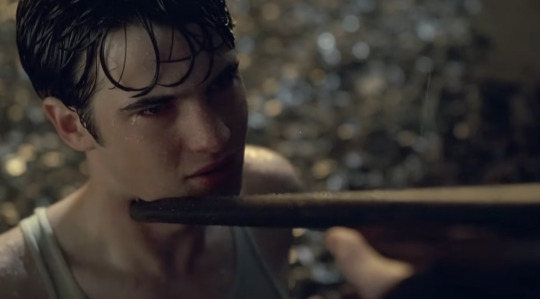
Pray for me. Pray for yourself. We are one now.



Contents:
1. Introduction 2. What We Know 3. The Investigation 4. Bibliography for Nerds

1. Introduction
Some justifications first.
I'm an undergraduate stem student obssessed with many topics, including forensic studies. I just finished a complete course about forensic chemistry/tecnology/law in uni and yes, I'm a big failure of a person and was thinking about applying some of the things I've learned into Like Minds' train scene. To clarify, I'm not an experienced profissional of the field. It is to say, I've never worked in such area and had just one or two significant interaction with said profissionals and students. My considerations won't be 100% accurate, clearly, and I may mistake or ignore fundamental data and studies. I intend solely to present some interesting facts and rapidly discuss their applicability here.
Take everything I say with large grains of salt, this is mostly for my enjoyment.
Let's kill Nigel!
2. What We Know
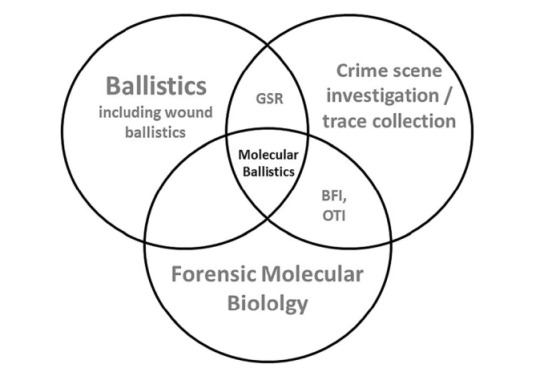
Figure 1. Visual diagram of forensic ballistics' main areas of study. Some will be mentioned here. [1]
2.1. Ballistics - Anatomy of a Discharge
Ballistics is a science field divided in three main ramifications: (1) Interior Ballistics, (2) Exterior Ballistics and (3) Terminal Ballistics. (1) studies the mechanism of a gun discharge, (2) studies the trajectory and behavior of a projectile once it is ejected from a firegun and (3) studies the damage and overall interaction of the projectile with a material structure (biological or not). [1] Ballistics experts (chemists, some engineers, law experts, etc) ocuppy themselves with many things regarding firearms, a field of work that recuries much study and understading of multiple fields of knowledge such as spectroscopy, law and general legislation, physical properties of chemical coumponds, solid state science, material science, industry production series and others. Some areas of chemistry and biology are of great importance and are commonly used complementarily.
We then understand what bullets are. The component that effectivally hits the target in these scenarios is the actual "projectile".

Figure 2. Simple structure of shotgun (left) and rifle (right) ammunition. [2]
In simple terms, they're composed by (1) a shell that holds everything together, (2) some coumpond responsable for the liberation of gas via chemical reaction and (3) some way to give the heat needed for said reaction to occur. There is a whole field of study and production of these killing objects that seeks out to balance some of their properties in different scenarios by the armamentist industry in oder to supply endless applications that constantly develops new shapes and components, so going through it all would be impossible. Regardless, all ammunition is classified by size, called "gauge" in shotguns, and "caliber" in rifles and handguns. [2]
Case: [in shotguns] It is a small cilindrical piece made out of a tube of common plastic or sturdy paper (the red/blue/colored part) that holds the multiple projectiles to be fired (shots), with a metallic base (the primer) composed of brass (copper and zinc) or steel (iron and carbon). [in rifles] The case is called cartridge case, and it is composed by brass as well. [2]
Powder (or propellant): They are usually Nitroclelullose (handguns), Nitroclelullose/Nitrogliceryn (rifles) and Nitroclelullose/Nitrogliceryn/Nitroguanidyn (long range rifles) [3]. Oversimplifying, organic molecules containing nitro groups (present in Nitroclelullose, Nitrogliceryn and Nitroguanidyn) are really unstable; these chemical groupaments are highly reactive in face of many scenarios. If enough energy is provided (by heating, or mechanical contact and pertubation) they will enter a decompostion process, breaking and reacting with their own bonds spontaneously, liberating gases such as H2O, N2 and CO2. These mentioned gases are much more stable compared to the original organic coumponds, so the atoms will "prefer" to form these species if the conditions are set (thus, a spontaneous reaction). This increases pressure inside the shell and forces the projectile to leave violently as a result of gas expansion. [4] Shotgun powder is composed by potassium nitrate, charcoal and sulfur; a mixture known as "dark powder", and it is separated from the shot (projectiles; multiple balls of steel, lead, rubber, or really anything) by a small component called "wad". The same principle explained in the decomposition of organic nitro-compounds apply for the potassium nitrate present here, but only in the presence of sulfur (easier to melt and ignite), providing the necessary heat for potassium citrate to generate the oxygen needed, resulting in charchoal's combustion. [2]
Primer: Primers are a fundamental part of any ammunition, and yet a simple one. When a firing pin from the firegun hits them, sparkles and heat will be produced, which gives the propellent all requiered energy for the chemical reaction. It is, when the action lever is pulled, the firing pin is tensioned by a spring inside the gun. When the trigger is pulled, this firing pin hits rapidly the ammunition's primer (metallic base). [5]
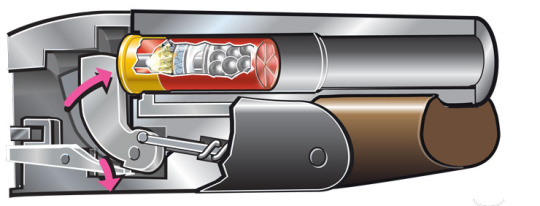
Figure 3. Shotgun firing pin scheme. [5]
The discussion of differents powders/propellents (like smokeless powder), projectiles shapes (in rifle cases) and firegun types (other than rifle and shotgun) is being ignored.
All that must be known is: the trigger pulling promotes a mechanical impact against the ammunition base, which promotes chemical reactions that liberate great amounts of gases, increasing the pressure inside the case, what will pushes the projectile(s) inside foward with great speed.
2.2. The Shotgun - Means to An End
We now restrain ourselfs to the firegun. Let us take a look on the following images:
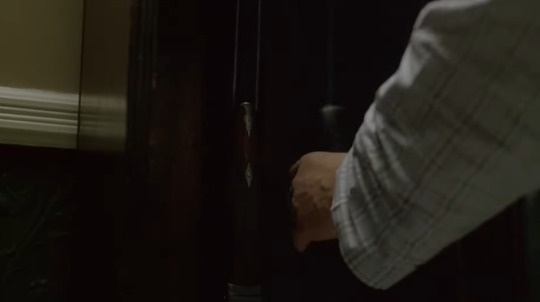
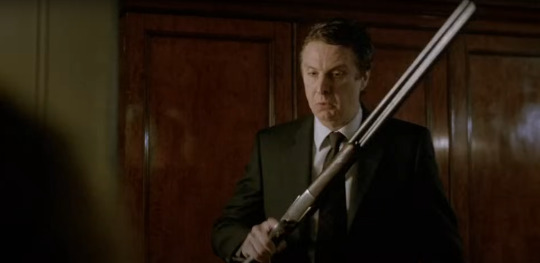
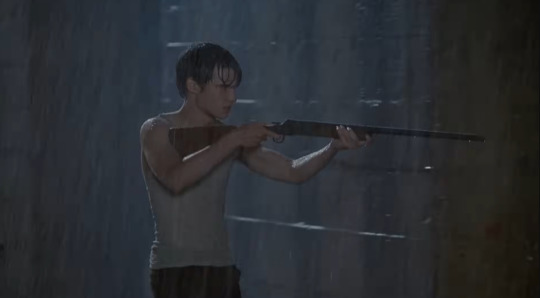
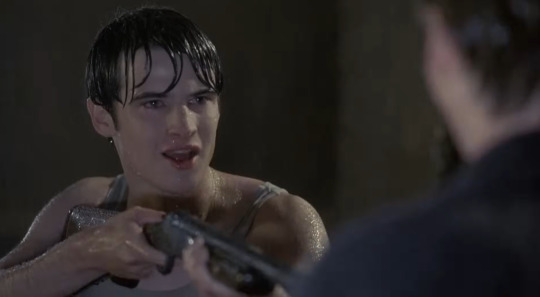
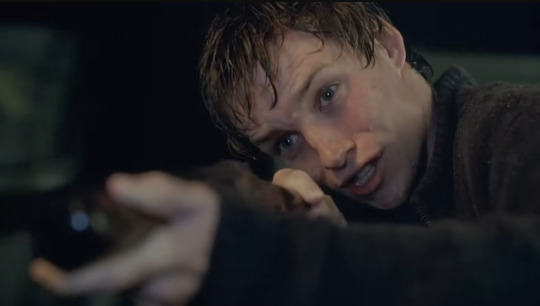
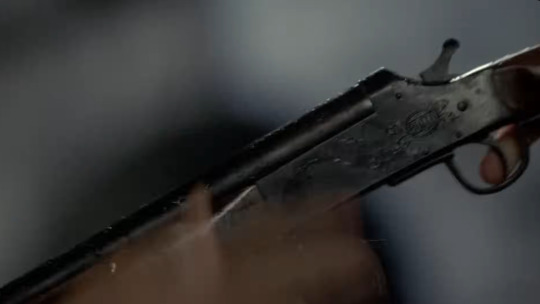
Figures 4-9 (left to right, top to bottom). Shotguns' takes from Like Minds (2006).
Main considerations:
The shotgun used by Mr. Colbie isn't the same one used by Nigel/Alex in the train scene. We can clearly point that by the number of barrels, i.e., two barrels contaning two projectiles (killing Nigel's mother and father without visible activation) in its first appearance, and only a single one in its second appearance. Maybe this has been discussed before.
It is not a narrative problem if we have the eyes for it. Nigel's father possesses two shotguns, so we assume Nigel went back and grabbed the single-barrel one before going after Alex.
The reloading thing would be important during the bedroom scene, between the moments where John shoots his wife and Alex picks up the gun from the floor. There would be no way of aciddentially shooting Mr. Colbie wihout Alex pulling the action on the second barrel (how would he know which one of the barrels were loaded and why Mr. Colbie would only activate one of the two barrels? It appears he wasn't using the shotgun to merely scare his family). Perhaps the double barrel shotgun used has some individual firing feature, perhaps.
Also, the single barrel shotgun is the same one used by John when Alex and Nigel first accessed the hidden baseament together. This isn't of great relevance though.
After a compulsive research in gun sale sites and over 900 models of shotguns (no joking), I'm inclined to believe that Nigel's single barrel shotgun is an Era 410 GA Single Shot Break Action. My conclusions is based on Figures 6 and 9, the shotgun's best takes throughout the entire movie. The important details are: a single barrel, with rounded trigger guard that ends exactly where the wooden stock begins, by a rounded break action lever with squarish shape that leans horizontally to the receiver and a rectangular like forestock. Other smaller details are: the receiver's top shape and really curved back, the declination present on the stock and the three screws' position and size.
The engraved symbols on Colbie's receiver are sculpted by a profssional artist called "engraver", by client's demand. Therefore, these sigils are decorative and probably carry some meaning to the shotgun's real owner, so they aren't a discrepancy to worry about. The frame I acquired (Figure 9) is of poor quality and there's nothing I can read in there besides one or two letters. I've tried to watch the movie in other internet sites but it didn't help that much.
It took me forever, but here it is [6], [7]. There are also youtube videos revewing this gun in the Extra section.

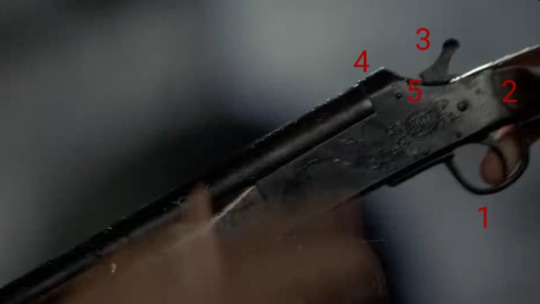
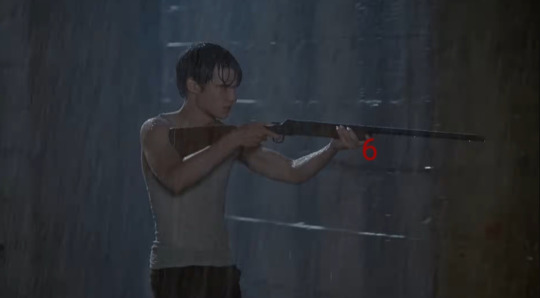

Figures 10-13. Era 410 GA Single Shot Break Action Shotgun. [6]
Note: @laurelwen successfully identified Nigel's firegun as a Boito .410. The text engraved on the shotgun's receiver in Figure 9, in fact, reads "Boito". Check it out on this post. Look up Extra Bibliography No. 7 in the shotgun's section as well.
Shotguns are a really old type of gun from the 16th century. Their mechanisms were adjusted during following centuries, but they remain still to date with an extremely simple way of function. Today, there are many types, including the single-shots and hand shotguns, much different than what was originally conceived. A break shotgun is capable of "breaking in half" for reloading, exposing its ejector/extractor and barrel interior just as many other fireguns. [8]

Figure 14. Break action shotgun anatomy. [9]
The Era 410 GA possesses a specially long length of barrel, which helps projectiles to achieve maximum velocity before leaving. Still, it appears from my research that this is a second hand model with low price, low demand and little historical relevance. This is the type of gun that would be bought mainly by collectors and enthusiasts; however, because of its little weight, good shooting and minimalist elegance, this firegun is not one of the worst models out there for small amateur animal hunting.
A 410 (10.41 mm, one smallest shot diameter in the market) with great pattern of dispersion after the discharge isn't bad, so at medium distances most projectiles would succesfully hit the center of a target. This is not very good when we're talking about a point-blank discharge directly at Nigel's face.
3. The Investigation
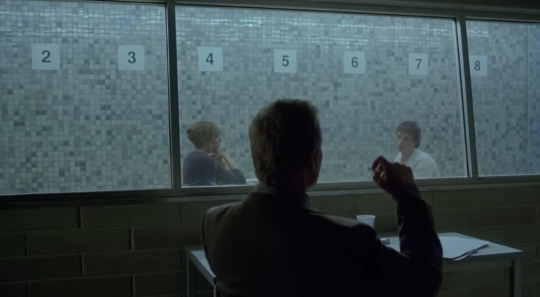
Figure 15. "If they had any evidence, I wouldn't be talking to you, would I?"
Authorities arrive at the dark, umid and isolated train tracks. Immediatly, a shocking scene: a desperate young man holding in his arms the corpse of a dead boy, disfigured. They transport the living witness away from the scene, but the lying unknown and deformed body is extracted for further autopsy. Detective McKenzie takes over with Forensic Psychiatrist Sally to interrogate the surviving suspect, Alex Forbes.
After the initial approach and first hours of interaction, the case takes an unexpected form. The question now is, did Alex Forbes shoot the now identified Nigel Colbie alone, or did Colbie participated in his own killing to incriminate Alex?
The police wastes its time thinking about common scenarios described in the book. They know the victim, the place where it happened, the exact gun used and the main suspect. Everything comes down to answering the presented question. Psycological attempts of extracting an answer from Alex by closed sessions with Sally, it is, to try and build a thrust and comfort relation with the suspect in order to obtain a confession would be protocol. But Alex clearly is beyond that, and if we must say, he's in control the whole time.
All that is left for the police is to attach towards factual evidences. Now, we describe two fundamental forensic elements of a gun-related crime.
Gunshot Residues (GSRs)
GSRs are one of the strongest evidences when it comes to forensic studies. Being composed of burnt and unburnt organic or inorganic particles from the explosive primer from the shell, propellant and possibly fragments of the bullet, cartridge case, and even the firearm, they frequently contain elements such as Sb (antimony), Ba (barium), Pb (lead) or Zn (zinc), Cu (cooper), and Ti (titanium). Their deposition concentrates away from the firearm into the shooter's (arms, face, hands and chest mainly) and victim's (region of contact mainly) bodies. GSRs can be found in nearby surfaces as well, such as the floor, ceiling, walls, objects, clothes, etc. The direct deposition of these residues must be carefully used as evidence because of its irregular distribution on the surrounding enviroment after the discharge. Thus, the main factors are always the chemical composition and concentration spots. Shotgun shots (the small spherical projectiles) are usually made up of lead or lead/antimony, but some ammunitions use steel, zinc-plated steel, tungsten and bismut in substitution (So, in our case, we can expect more significant ammounts of antimony/lead or zinc, iron and carbon). [10], [11]
A 410 ammunition is classified as "birdshots" ammunition, used for hunting said animals. The little diameter of projectiles allows the carrying of multiple projectiles inside one shell, facilitating the execution of small moving targets. The potential damage mustn't be underrated, though.
The aforementioned substances/elements can be detected, investigated, and quantified using microscopy, chemical analytical and chemometric methods, such as Scanning Electron Microscopy (SEM), Energy Dispersive X-Ray Spectroscopy (EDS), Atomic Absorption Spectroscopy (AAS) and Energy Dispersive X-Ray Fluorescence (EDXRF). All these techniques are extensively known and applied in uncountable areas of science for identification and characterization of solid materials. In a nutshell, these methods revolve around the interaction of matter with radiation (such as X-Rays) and the energy absorved/emitted by it after the interaction. The SEM is a most usefull analysis for it can provide real images of micro structures and particles present above any surface, like clothings, skin, fifregun metal and others, if properly prepared. [10]
It is important to understand that these identification methods are of extreme precision and sensibility, it is, minimal concentrations can and will be detected inneviatbly.


Figure 16 and 17. (Left) Image of gunshot powder residues dispersed in the air after discharge. Top left and (Right) images refer to SEM "photos" of extremely small particles of GSRs that can be chemically analyzed. [12], [13]
What about the lifespan of these residues? In long terms, the shooter's trigger hand (right hand) seems to contain most of the residues that persist for a fair amount of time after the discharge. [10] Unffortunately, the mentioned study occured in controlled enviroments, which is not the case. Another work [14] concludes that most GSRs are lost after two-four hours from the discharge. Considering the fast action from authorities described in the movie, we can basically ignore this factor and consider other variables.
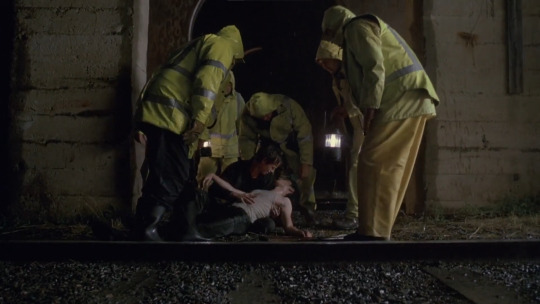
Figure 18. "All I can tell you, was that the heavens were falling. And the sound... it was incredible. It was like the Gods were rejoicing for what was done."
Backspatter Material (BM)

Figure 19. Distribution of Forward Spatter and Backspatter caused by a shot at a biological target. [1]
We hereby exclude the forward spatter, it is, the biological material projected fowards with the projectile (to the back of Nigel's head), for its little relevance, since we're not questioning the type of gun or ammunition used; we assume that Alex is describing a resonable scenario that matches with the actual damage done to Nigel. There are no consistent reasons to question this since everythings seems to support Alex's description of this.
BM comes from the combined forces of several interacting wound and ballistics effects. The collapse of the wound cavity and balance of resulting overpressure, the stream of liquid and tissue particles accelerated along the lateral surface of the projectile, the shot's contact and ejection of muzzle gases out of the entry wound from the powder cavity... Every surrouding surface must be investigated, that is, even the shotgun barrel's interior. This small ambience is fairly protected from external pertubations and houses BM from the shot. Considering the poximity with Nigel's face, we can almost assure to encounter biological material with DNA inside. The bellow mentioned study cites another work where a 9 mm pistol cointaned backspatter material from test targets even at a distance larger than 1 meter, much greater then the few inches that separated Nigel's face from the barrel. [1]
Matter of fact, this biological material can pass by processes of Organ Tissue Identification (OTI) and Body Fluid Identification (BFI) if Nigel's identity was at question, or if we desire to understand more profundly the projectile's damage caused to his skull/face/tissue. [1]
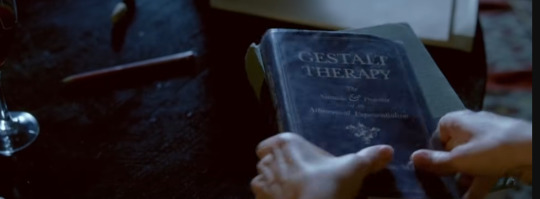
Figure 20. "None of what I've heard makes him a murderer."
So, how can we gather this up to develop the investigation? Utilizing only these two fundamental concepts, we can make a few assumptions.
The big question here is if whether or not Nigel's hands were present by Alex's when the trigger was pulled, which would lead the police to support or oppose Alex's narrative. Chemical examination with organic solvents (which won't cause preocupant harm to a dead body) and analytical methods could immediatly point to the presence of GSRs or biological/non biological BM. If Nigel's hands were elevated in his head level (or superior) in the instant of discharge, trace amounts of discussed metals/elements coming from the firing mechanism and ammunition, as weel as little to some biological material, would definetly be found in his hands and forearm skin since there was no clothing covering. Any substance found in his hands/forearm could be microanalytical compared to the ones present in Alex's hands, clothes and face as well. This could be done with really small samples of fresh skin. On the other hand, if Nigel's arms were lowered at the instant of discharge, we could still expect the presence of GSRs in his arms (yet, in less amounts) but the abssence of backspatter materials most certantly. This would classify Alex as a murderer without excuses, even if he alleged that Nigel asked for it.
In the scenario where Alex discharges at Nigel from a great distance (configuring simply murder) we could note the abssence of GSRs in every part of Nigel's body except for the targeted region (perhaps if they were at a greater distance to each other) and the presence of these GSRs in Alex, but in much higher concentration.
But the enviromnent's conditions are of primordial importance. Nigel and Alex stand in an open area, with considerable wind, heavy rain and gravel soil. The heavy rain could simply carry way much of these residues from Alex's body, clothes and Nigel's hands as well. Most GSR would probably be lost to those conditions and its deposite upon the soil's surface would be extremely hard to be quantitatively analized due to unknown degrees (elevated) of impurities and diverse materials and dirt present, but qualitative tests would still be valid.

The knowledge about the victim, crime scene, shooter, exact firegun and time of the tragic event allied with the fast action from authorities saves most of the police's efforts on identifiying and tracking down evidences. However, what remains still offers a challenge. The best evidence here, GSRs left by the discharge, would be of questionable help considering the presence of heavy rain in sight. Still, analitical quantities of them, if detected in Nigel's skin by proper chemical and espectroscopy-related analysis, can be used to comparate probable ammounts present in Alex's clothing and skin (despite the difficult of such). With that being said, the police would find themselves in a much more complex case of muder/assisted suicide, and further evidences and information about their relationship and recent whereabouts would ineviatably need to be extracted from external sources (such as parents, school's employess, close friends and students). Despite all this, Alex's final acting of removing Susan's body and disapearing from sight (not to mention the card left in Sally's car) immediatly sustent his guilt in a case where he already was the main suspect and basically confirmed criminal. And you know, breaking into a cemetery and extracting a corpse from its grave is definetly worth of some jail time. The Colbie's House Murder would certainly incriminate Alex for homicide as well, and the current Brotherhood's little political influence wouldn't prevent him from this destiny, as it appears. But the case is not over.
Further evidences were to be discussed, if it was not for the dissapearing of Alex Forbes.
The subject now roams unknowingly through England with mysterious intents. Its participation on the described case still lacks formal arguments and the Court should now approve his arrest warrant and search decree. Alex Forbes will most probably live to perpetrate the deluded fantasy responsable for the death of three young students in order to carry the sacred holy burden of an ancient templar bloodline.
Yet, we pray.


Who's the enemy now? We are.
4. Bibliography
[1] Euteneuer J, Courts C. Ten years of molecular ballistics-a review and a field guide. Int J Legal Med. 2021 Jul;135(4):1121-1136. doi: 10.1007/s00414-021-02523-0. Epub 2021 Feb 16. PMID: 33594457; PMCID: PMC8205864. [2] https://spotterup.com/how-ammo-works/ [3] Serol, M.; Ahmad, S.M.; Quintas, A.; Família, C. Chemical Analysis of Gunpowder and Gunshot Residues. Molecules 2023, 28, 5550. https://doi.org/10.3390/molecules28145550 [4] Guanchao Lan, Jing Li, Guangyuan Zhang, Jian Ruan, Zhiyan Lu, Shaohua Jin, Duanlin Cao, Jianlong Wang, Thermal decomposition mechanism study of 3-nitro-1,2,4-triazol-5-one (NTO): Combined TG-FTIR-MS techniques and ReaxFF reactive molecular dynamics simulations, Fuel, Volume 295, 2021, 120655, ISSN 0016-2361, https://doi.org/10.1016/j.fuel.2021.120655. [5] https://www.hunter-ed.com/national/studyGuide/How-the-Shotgun-Shoots/201099_92815/ [6] https://www.invaluable.com/auction-lot/era-410-ga-single-shot-break-action-shotgun-131-c-8284a72a5b [7] https://firearmland.com/item/1079096107 [8] https://www.letsgoshooting.org/resources/articles/shotgun/meet-the-shotgun/ [9] https://www.atf.gov/firearms/firearms-guides-importation-verification-firearms-ammunition-and-implements-war-top-break [10] Virginie Redouté Minzière, Céline Weyermann, Organic and inorganic gunshot residues on the hands, forearms, face, and nostrils of shooters 30 min after a discharge. Science & Justice, Volume 64, Issue 5, 2024, Pages 557-571, ISSN 1355-0306, https://doi.org/10.1016/j.scijus.2024.08.002. [11] Joshua Hallett, Michael Stolk, Michael Cook, K. Paul Kirkbride, Examination of gunshot residue arising from shotgun cartridges containing steel, bismuth or tungsten pellets. Forensic Science International, Volume 306, 2020, 110096, ISSN 0379-0738, https://doi.org/10.1016/j.forsciint.2019.110096. [12] https://www.bka.de/EN/OurTasks/SupportOfInvestigationAndPrevention/ForensicScience/PhysicalEvidence/Homicide/GunshotResidue/gunshotresidue_node.html [13] Francesco Saverio Romolo, Pierre Margot, Identification of gunshot residue: a critical review. Forensic Science International, Volume 119, Issue 2, 2001, Pages 195-211, ISSN 0379-0738, https://doi.org/10.1016/S0379-0738(00)00428-X. [14] Jalanti, T & Henchoz, P & Gallusser, Alain & Bonfanti, M.S.. (1999). The persistence of gunshot residue on shooters’ hands. Science & justice : journal of the Forensic Science Society. 39. 48-52. 10.1016/S1355-0306(99)72014-9.
Extra
random materials, take a look
1. Chemistry of Explosives (book pdf) https://link.springer.com/chapter/10.1007/978-1-4612-0589-0_5 2. ERA 410 GA video 1 https://www.youtube.com/watch?v=lGWm2aaWVAc&ab_channel=SteadFastCourage 3. ERA 410 GA video 2 https://www.youtube.com/watch?v=2S16C5Y6lxY&ab_channel=esquad540 4. Quick discussion about Smokeless Powder on r/guns https://www.reddit.com/r/guns/comments/1tawwm/things_i_want_you_to_know_about_smokeless_powder/#:~:text=Because%20of%20something%20called%20oxygen,and%20temperatures%2C%20leading%20to%20fouling. 5. A little on the kinetic energy of specific projectiles (everything applies here as well) https://nodoroc.com/d/node/20 6. A little more on ammunition Caliber https://www.globalsecurity.org/military/systems/munitions/bullets2-types.htm#google_vignette
For the sake of archieving, here are some shotguns I've separated to double check during my research until the Era 410 GA appeared. Curious enough, number 7, called "boito", appears to be another common name given to Era 410. Woops.
1. https://www.bidsquare.com/online-auctions/north-american-auction/victor-break-action-single-shot-12-ga-shotgun-4988316 2. https://www.crescentcityauctiongallery.com/auction-lot/stevens-arms-.410-gauge-single-shot-break-open-sh_9F84899825 3. https://palmettostatearmory.com/jts-shotguns-single-shot-410-bore-26-single-shot2.html 4. https://en.wikipedia.org/wiki/File:Stoeger-Coach-Gun.jpg 5. https://www.gunsinternational.com/guns-for-sale-online/shotguns/harrington-richardson-shotguns/h-r-bay-state-20-ga.cfm?gun_id=103017190 6. https://www.bankstowngunshop.com.au/product/12g-unknown-model-unknown-single-barrel-blued-wood-28-barrel-poor-condition/ 7. https://www.bankstowngunshop.com.au/product/410-boito-model-reuna-28-single-barrel-blued-timber-3-chamber-sec9622/ 8. https://www.bankstowngunshop.com.au/product/12g-harrington-richardson-model-1908-single-32-barrel-blued-wood/ 9. https://www.bankstowngunshop.com.au/product/12g-norinco-model-std-single-barrel-30-shotgun-great-condition/
10. https://www.bankstowngunshop.com.au/product/12g-raick-freres-model-unknown-single-barrel-30-shotgun-belgium/ 11. https://gritrsports.com/henry-repeating-arms-single-shot-12ga-shotgun-h015-12 12. https://www.tmguns.co.uk/store/p1418/Tomas_Agote%2C_Eibar_12G_single_hammer_ejector_shotgun.html 13. https://www.tmguns.co.uk/store/p1659/Vanguard_Game%2FVermin_.410_hammer_ejector_single_barrel.html 14. https://www.tmguns.co.uk/store/p1290/Astra_Ciclope_12G_single_barrel_hammergun.html 15. https://www.tmguns.co.uk/store/p1883/Rossi_Game%2FVermin_20G_single_hammer_ejector_shotgun.html 16. https://en.wikipedia.org/wiki/File:Stevens_511_Shotgun.jpg 17. https://www.gunsinternational.com/guns-for-sale-online/shotguns/harrington-richardson-shotguns/harrington-richardson-44-smoothbore.cfm?gun_id=102901609
thank you for reading

#like minds#murderous intent#nigel colbie x alex forbes#nigel colbie#alex forbes#forensic science#analysis#Spotify
48 notes
·
View notes
Text
ੈ✩ Habits for your academic life
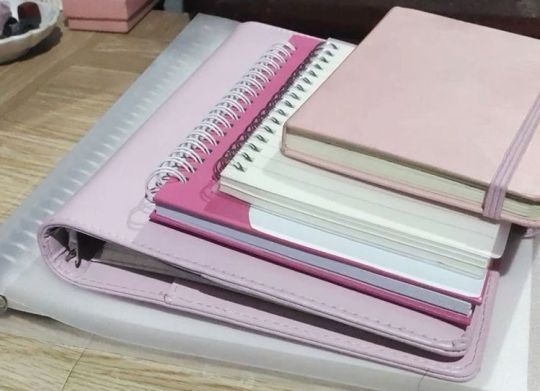

Below are some habits and rules to keep in mind throughout your studies and some tips that will elevate your learning experiences.
☆ Setting boundaries and learning to say no
It is always easy to say yes and join every social event that one is invited to, however its crucial to consider your own personal life and the consequences of your decisions. Hanging out with friends is a needed event as a social creature, however it's better to exercise caution and know when to say "no" to focus on your own goals and dreams. Don't get pulled into the pace of others and focus on finding a routine and schedule that works for your own benefit.
☆ Being comfortable with your own company
You will find in uni that there are lots of times that you will spend alone, and maybe feel a little anxious that you're the only person who isn't constantly in the company of someone everyday like you maybe were in high school. However, realise that even the time to yourself is a time of value, and treasure those moments to focus and work on your own goals. It is easier to get lost and lose sight of your ambitions when with others who don't have the same aspirations as yourself. Use your own time to sit down and work out what you want to achieve and quietly put in the effort to win.
☆ Never being scared to ask questions
It can be quite daunting to ask questions in lectures, so I prefer to ask my questions during times that aren't forced into a short time interval, such as tutorials, office hours, and other forms of learning support that your university/college provides. This way there is no rush to answer my questions and take my time in working through concepts and ideas. Ask questions based on your own conclusions, questions that challenge current rules and perspectives. Think deeper into your lessons and seek to make use of every bit of information.


☆ Being curious
This is very much related to the point above, that being that personal interest really aids with the brains memory retention. The more things you approach with an enthusiastic attitude, the easier it is for your brain to remember and categorise. Having curiosity, even if it is forced, gives a great advantage where you seek to interconnect the information you learn with other data, and grow more networks of neurons that allows your brain to stay healthy and active.
☆ Initiating contact
Struggling with a theory or assignment? Great, it shows that you are actively trying to understand a concept and working your brain muscles. Now the best way to comprehend or complete what you are struggling with is to access support materials. Still difficult? Reach out. Your teachers, professors, tutors are all there for your benefit. Use them intelligently and squeeze every drop of assistance and support from them while they are still available to you.
☆Watching educational content to aid your studies
You can never lose from learning a bit more every day. However make sure to fact check and find your information from trusted and quality sources. In general, it's always a win to be educated in various topics from health, sciences, arts, humanities and more to gain a better understanding of ourselves, our world, and humanity.
For example, I watched a ted talk today, and here is my conclusions from my notes:
ੈ✩TedX: Why Reading Matters by Rita Carter
Summary:
☆Your brain needs a workout as much as your body. And reading fiction seems to be one of the best workouts you can get. (I recommend quality fiction, with that being classic literature because it genuinely exercises your mind with its intricate language techniques and diverse vocabulary)
☆Not only is it good for you, but it's also good for society as a whole because the brain is like a muscle: the more you force yourself through books to take other people's perspectives, to sympathise, to empathise with other people, the more empathetic a society we will have.
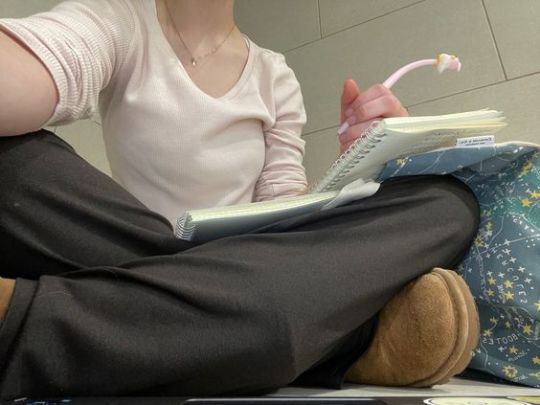
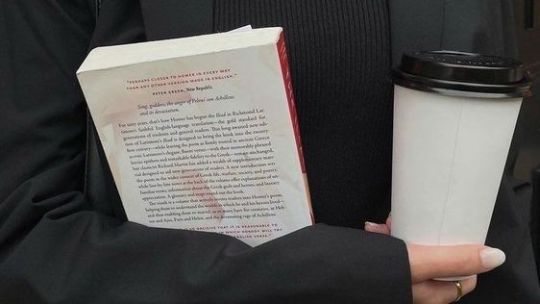
ੈ✩‧₊˚
good luck lovelies
~winter
ଘ(੭ˊᵕˋ)੭* ੈ✩‧₊˚
#university student#self concept#studyblr#study#studygram#study motivation#student life#student#studying#university#uniblr#education#personal growth#personal development#glow up#college#college student#aesthetic#college life#assignment#science#study techniques#study aesthetic#overachiever#divine feminine#manifestation#successmindset#it girl#pink pilates girl#high value mindset
438 notes
·
View notes
Text
This post is about AI editing and English improvement for non-native speakers. It is not about coming out with crazy word counts in mere days. It has come to my attention that I misunderstood the situation greatly as someone new to the fandom and assumed it was only about editing. Many thanks to the poeple who took the time to let me know. Please read it accordingly.
Because this has been stuck in my head since yesterday, I need to get it out: in 2020, one of my favorite fic writers at the time (who was not a native English speaker and was studying creative writing in uni) mentioned that she has started using this tool called Grammerly for both her fics and uni work. In fact, as far as I remember, her teachers were the ones to encourage it.
I work in IT, I graduated with a computer science degree and have strong ties with the machine learning field (AI). The first transformers paper came out in 2017 (i.e., the technology behind what we refer to as AI today). It was clear to me in 2020 that Grammerly had to use some sort of transformer model (obviously less capable than what became Chat GPT, trained on much less data). In 2021, I discovered another tool called QuillBot which I used as an automatic Thesaurus (synonyms that don’t come naturally to a non-English speaker, some topic rephrasing where the sentence sounded too much like it was written in my native language) for my disertation. Again, it was clear to me there was a transformer behind it.
When ChatGPT came around is when I actually thought, okay, I personally do not want my writing of any kind to go as possible trainining material to you, because it was no longer an English improvement tool, it could create it’s own thing and I was not comfortable with that. That doesn’t mean I don’t ask ChatGPT to tell me verbs that describe a certain action etc, I just personally won’t ever feed it my writing (or anyone elses).
Given all of this, if I hear someone uses AI tools for editing (like Grammerly, that I believe is very popular to this day), I don’t bat an eyelash. It’s normal in my opinion, especially for non-native English speakers. Check r/writers on Reddit to see how many poeple do the same thing. I always took it as a quality of life improvement, and nothing can change my mind about it.
Yes, AI companies stealing AO3 works to train their models and generate stories that make profit based on it is hideous and wrong. A non-native English speaker using paraphrasing tools by their own choice to improve their English will never be wrong in my eyes.
#sincaraz#tagging this as sincarz because what the hell#i am prepared for backlash#i’ve been told it’s good exposure theraphy anyway
22 notes
·
View notes
Text
Come join the Fandom Data Projects community! (You don't need to have a project or any relevant background... just curiosity 🤓)
Apparently I can't reblog the community post I made outside the community, so to quote myself:
Hello, fans of fandom data science, fandom research, fandom stats, fandom surveys, fandom data visualization, and everything related! 🪭📊📈📋📓🎉🎉🎉 I run a blog called @toastystats , and I love fandom data! I am starting this community for folks with a personal or academic curiosity about fans/fanworks and a desire to answer questions with data 🧑🔬. All of the following are welcome here: * Sharing questions about fandom and brainstorming ways to gather relevant data; * Sharing analyses & insights; * Trading tips on how to gather or analyze data; * Chatting about methods; * Asking for volunteers to participate in surveys or help gather data; * Anything else related!
Learners and lurkers are welcome. Drama and discourse are not; please be thoughtful and generous in how you participate in the group, and try not to stir controversy. (That's not to say there aren't valid fandom research topics that involve controversies -- but the goal of this space is to focus on people helping each other with research and learning in a low stress environment.)
(Honestly I'm starting this partly because I'm curious about the Tumblr community feature, and I like to learn by trying things. 🤓 We'll see how this goes.)
93 notes
·
View notes
Text
This is a good starting point but its not exhaustive by any means...
#Research 101: Part 1
## How to find a good research topic?
It’s best to familiarize yourself with a discipline or topic as broadly as possible by looking beyond academia
Tips:
Be enthusiastic, but not unrealistic. For example, you might be tempted to throw yourself into finding out to what extent an entire economy has become circular, but it may already be challenging and tricky enough to find out which building materials are being recycled in the construction sector, and in what ways.
Be open-minded but beware of cul-de-sacs. You should always find out first whether enough is known about a topic already, or you might find yourself wasting a lot of time on it.
Be creative but stay close to the assignment. This starts with the topic itself; if one learning objective of the assignment is to carry out a survey, it isn’t helpful to choose a topic for which you need to find respondents on the other side of the world. One place where you can look for inspiration is current events.
Although professors and lecturers tend to be extremely busy, they are often enthusiastic about motivated and smart students who are interested in their research field. You do need to approach them with focused questions, though, and not just general talk such as: ‘Do you know of a good topic for me?’ In many cases, a good starting point is the scholar themselves. Do a search on them in a search engine, take a look at their university web page, read recent publications,
In most university towns, you’ll come across organizations that hold regular lectures, debates, and thematic evenings, often in partnership with or organized by university lecturers and professors. If you’re interested in transdisciplinary research where academic knowledge and practical knowledge come together, this is certainly a useful place to start your search.
If you want to do interdisciplinary research, it is essential to understand and work with concepts and theories from different research fields, so that you are able to draw links between them (see Menken and Keestra (2016) on why theory is important for this). With an eye to your ‘interdisciplinary’ academic training, it is therefore a good idea to start your first steps in research with concepts and theories.
##How to do Lit Review:
Although texts in different academic disciplines can differ significantly in terms of structure, form, and length, almost all academic articles (research articles and literature reports) share a number of characteristics:
They are published in scholarly journals with expert editorial boards
These journals are peer-reviewed
These articles are written by authors who have no direct commercial or political interest in the topic on which they are writing
There are also non-academic research reports such as UN reports, data from statistics institutes, and government reports. Although these are not, strictly speaking, peer-reviewed, the reliability of these sources means that their contents can be assumed to be valid
You can usually include grey literature in your research bibliography, but if you’re not sure, you can ask your lecturer or supervisor whether the source you’ve found meets the requirements.
Google and Wikipedia are unreliable: the former due to its commercial interests, the latter because anyone, in principle, can adjust the information and few checks are made on the content.
disciplinary and interdisciplinary search machines with extensive search functions for specialized databases, such as the Web of Science, Pubmed, Science Direct, and Scopus
Search methods All of these search engines allow you to search for scholarly sources in different ways. You can search by topic, author, year of publication, and journal name. Some tips for searching for literature: 1. Use a combination of search terms that accurately describes your topic. 2. You should use mainly English search terms, given that English is the main language of communication in academia. 3. Try multiple search terms to unearth the sources you need. a. Ensure that you know a number of synonyms for your main topic b. Use the search engine’s thesaurus function (if available) to map out related concepts.
During your search, it is advisable to keep track of the keywords and search combinations you use. This will allow you to check for blind spots in your search strategy, and you can get feedback on improving the search combinations. Some search engines automatically keep a record of this.
Exploratory reading How do you make a selection from the enormous number of articles that are often available on a topic? Keep the following four questions in mind, and use them to guide your literature review: ■■ What is already known about my topic and in which discipline is the topic discussed? ■■ Which theories and concepts are used and discussed within the scope of my topic, and how are they defined? ■■ How is my topic researched and what different research methods are there? ■■ Which questions remain unanswered and what has yet to be researched?
$$ Speed reading:
Run through the titles, abstracts, and keywords of the articles at the top of your list and work out which ideas (concepts) keep coming back.
Next, use the abstract to figure out what these concepts mean, and also try to see whether they are connected and whether this differs for each study.
If you are unable to work out what the concepts mean, based on the context, don’t hesitate to use dictionaries or search engines.
Make a list of the concepts that occur most frequently in these texts and try to draw links between them.
A good way to do this is to use a concept map, which sets out the links between the concepts in a visual way.
All being well, by now you will have found a list of articles and used them to identify several concepts and theories. From these, try to select the theories and concepts that you want to explore further. Selecting at this stage will help you to frame and focus your research. The next step is to discover to what extent these articles deal with these concepts and theories in similar or different ways, and how combining these concepts and theories leads to different outcomes. In order to do this, you will need to read more thoroughly and make a detailed record of what you’ve learned.
next: part 2
part 3
part 4
last part
#studyblr#women in stem#stem academia#study blog#study motivation#post grad life#grad student#graduate school#grad school#gradblr#postgraduate#programming#study space#studyspo#100 days of productivity#research#studyabroad#study tips#studying#realistic studyblr#study notes#study with me#studyblr community#university#student life#student#studyinspo#study inspiration#study aesthetic
53 notes
·
View notes
Text
"I NEED TO TALK TO YOU"
I WROTE A FIC WITH REED RICHARDS
(The trailer aired today and I just love him so much guys, I'm so excited for this movie to come out like, the employers of the cinema told me that I've to leave but I can't I'm simply so seated for this one lol)
(ALSO, parts of the movie where shot in my freaking country, so I'm SOOO excited to see the locations on the big screen)
I hope you like it! 💛☝😊


It was the third time that week that you sat in the back of the physics and electrical engineering class, listening to Professor Richards.
You thought he wouldn't notice, but as the days went by, he realized that, after the first five minutes of his class, you would sneak in like a cat to take the spot closest to the wall.
You couldn't help but put on dreamy expressions as you listened to him explain theories, parameters, and calculations you had no idea how to do, but just hearing him explain them made you think you'd walk out of there a full-fledged military science expert like him.
The way his lively brown eyes focused intently on different people across the room made you look away from the board, avoiding bumping into him.
You didn't want him to see you.
You were afraid he'd think you were actually his student and ask you a question about the subject, which you wouldn't know how to answer.
He turned to face the blackboard, giving you a close-up of his strong, broad back.
You felt your cheeks heat up, and you ducked your head for a moment to look at your phone, distracted.
Then the class ended, and the students began to disperse.
"That's all for today," he smiled. "I hope you come back tomorrow with the same desire to learn as today," he said sarcastically. "You can all go…" He scanned the people who were leaving until his eyes fell on you. "Except you," he nodded. "I need to talk to you, privately."
When everyone had left and the class fell extremely silent, you started to get nervous.
You didn't want to be alone with him, especially not there. What if someone came in?
You blinked a few times to clear those thoughts before focusing on him.
His soft, kind eyes rested on yours before he smiled the same smile.
"You've stopped by to listen to several of my classes over the last week," he began, getting straight to the point, "so I thought it would be only right to introduce myself." He offered you his hand. "Reed Richards."
"I know who you are, Professor. I…" You shook his hand. "I'm a big fan of your work." "I'm glad to see someone so young is motivated by my classes." He smiled, and you thought you might faint right there.
"Is there anything about the subject that particularly catches your attention?" “Gauss’s law seems particularly interesting to me,” you said after a moment of thought.
“It’s an interesting topic,” he agreed. “Many scientists before me tried to define that concept without success, until 1835, when Carl Friedrich Gauss discovered the divergence theorem, which later became known as Gauss’s theorem.” He smiled. “But I can explain that to you another day. I’m sure you have more interesting things to do right now than be here with me.” He laughed.
“Not really,” you acknowledged, looking at your wristwatch. “We have exactly twenty minutes for you to explain that law to me in great detail.”
“More than enough time,” he murmured, nodding at you to take a seat in the front row of the classroom.
Twenty minutes later, you left the faculty with two full sheets of paper filled with data and formulas you didn’t understand, and a smaller piece of paper with Professor Richards’s number written on it.
#pedro pascal#fantastic four first steps#reed richards x reader#reed richards x you#byvoice#my fic writing#writters on tumblr#writterscommunity
49 notes
·
View notes
Text
If you are a scholar, or are well-versed in any kind of academic subject such as English, math, history, or anything like that…teach your F/Os about it! Infodump to your heart’s content! When it comes to it, you are the professor, and your F/O is the good student who always listens and takes notes. Even if they don’t fully understand what’s going on, I’m sure they’d love to hear the sound of your voice regardless.
Conversely, if your F/O is a scholar or well-versed in any academic subject, let them teach you about it! Your F/O is able to teach you something that will stick with you for life. And whatever you teach your F/O will stick with them as well. Take turns being the professor, and learning about various topics will become so much more fun!
I want to teach my F/Os about statistics and data science and all that, since I have a degree in the subject. Though they might not know much about it now, I’m sure they’d love it if I teach it to them, and even want to know more about it! It’d even be fun to let them teach me about subjects they know! :]
Please read my full DNI in pinned before interacting.
#self ship#selfship#self shipping#self shipper#selfshipper#selfshipping#self ship community#selfship community#f/o#f/o community
22 notes
·
View notes
Text
KOSA Update
Following up on a previous post about the KOSA bill - a bill that would drastically change how the internet functions, in some ways enforcing the collection of private information and restricting access to educational material based on anyone’s belief that it might be harmful to children.
As of March 2024, the bill has gone through revision to reduce the ability to target marginalized communities. However, the language used in the bill is still broad and would be ultimately harmful to children and adult internet users.
Press releases like that of the American Civil Liberties Union invoke the First Amendment to highlight both the bill’s continued call for requiring or incentivizing age verification and its goal of censoring many different topics of conversation in online spaces.
If the U.S. government seeks to control, censor, and otherwise interfere with the world of the internet, then it would have to be a government program akin to public education or certain libraries. Let that government take over the responsibilities of running and funding the internet in that case if they want that power. Otherwise, the internet does not fall under federal jurisdiction.
In response to reaching out regarding this bill, one Congressman wrote that platforms like TikTok have come under scrutiny for “leaving users’ data vulnerable to access by the Chinese Communist Party, by collecting personal information on children in violation of federal law”. This Congressman does not state in this response whether he supports the KOSA bill in particular, but we hope that he is aware that this proposed bill would, by federal law, necessitate the collection of personal information of minors if websites are to follow its requirements. Additionally, TikTok’s data collection is comparable to that of other sites such as Instagram and Facebook, which are just as able to be infiltrated by political enemies of the U.S.
This update is not about the U.S. government’s ultimatum to the company ByteDance that will likely end in a U.S. ban on TikTok. Still, that news is relevant to internet users, especially those who value choice and self-determination.
In the aforementioned Congressman’s response, he also mentions the Privacy Enhancing Technology Research Act (H.R. 4755). That bill, passed in 2023, calls for organizations like the National Science Foundation to conduct and support research into technologies for mitigating privacy risks. Bills like this one are far more conducive to achieving online safety than the proposed KOSA bill. It seeks to enhance our understanding of data handling and online privacy, while the KOSA bill is more so blindly punching towards a problem that we do not yet have a clear view of.
As before, resources to further learn about and speak out against the bill are below.
Resources:
1.https://www.aclu.org/press-releases/revised-kids-online-safety-act-is-an-improvement-but-congress-must-still-address-first-amendment-concerns
2.https://www.eff.org/deeplinks/2024/02/dont-fall-latest-changes-dangerous-kids-online-safety-act
3. https://www.stopkosa.com/
4. Privacy Enhancing Technology Research Act
5. KOSA Bill Post-Revision6.https://www.eff.org/deeplinks/2024/03/analyzing-kosas-constitutional-problems-depth#
#kosa bill#stop kosa#kosa#politics#us politics#article#news#resources#first amendment#freedom of speech
90 notes
·
View notes
Link
In a quiet part of Northern California, where pine trees brush the sky and the hum of giant satellite dishes fills the air, something big is happening in science education. A new wave of college students is getting the chance to explore the universe — not through textbooks, but with real data from a world-class observatory. Thanks to a growing program called ARISE Lab, students and teachers from community colleges are diving deep into the science of space, radio signals, and the search for alien life. The SETI Institute, which focuses on the scientific search for extraterrestrial intelligence, has expanded this groundbreaking effort. With new support from a grant by the Amateur Radio and Digital Communication Foundation, the ARISE Lab (Access to Radio Astronomy for Inclusion in Science Education) is now reaching even more classrooms across the country. Making Space Science Hands-On The main idea behind ARISE is simple: when students get to do science themselves, they understand it better and stay interested longer. “Hands-on experiences are proven to improve student engagement and retention,” said Dr. Vishal Gajjar, a radio astronomer who leads the project at the SETI Institute. That’s why ARISE puts real scientific tools directly into students’ hands. The Allen Telescope Array at Hat Creek Radio Observatory. (CREDIT: Luigi Cruz) The program uses GNU Radio, a free and open-source software that lets users process radio signals. This gives students a way to study actual data from the SETI Institute’s Allen Telescope Array (ATA). The ATA is the first and only radio telescope in the world built just for detecting signs of advanced life beyond Earth — also called technosignatures. With these tools, students don’t just read about pulsars, spacecraft, or distant stars. They study them. They learn to sort signals, find patterns, and understand how astronomers listen to the sky. What the ARISE Curriculum Offers Dr. Gajjar and his team built the ARISE curriculum using something called experiential learning technique, or ELT. This method focuses on learning by doing. Students start with pre-lab reading, move through guided lab work, and then reflect on what they discover. Related Stories How podcasts are revolutionizing health education and behavior Groundbreaking discovery promotes verbal learning and fights memory loss New AI-based learning system provides personalized math instruction for students ARISE includes two types of content: modules and labs. Modules are more complete packages that come with slides, notes, reading materials, lab manuals, and instructor guides. They are designed to be added directly into a science class. Labs, on the other hand, are shorter, standalone activities that can be used by themselves or as part of a larger lesson. The labs cover a wide range of topics. Students might explore signal modulation — the way information travels through radio waves — or learn how data science applies to astronomy. Each lab has step-by-step instructions that make it easy for both students and teachers to follow. By linking lessons to the search for extraterrestrial life, ARISE grabs students’ attention. Research shows that this subject sparks more interest than almost any other topic in science. “With ARISE, we’re combining cost-effective tools like GNU Radio with one of the most captivating topics in science — the search for life beyond Earth — to spark curiosity and build skills across STEM disciplines,” Gajjar said. Vishal Gajjar, SETI Institute. (CREDIT: SETI Institute) Real Tools, Real Signals, Real Skills The ARISE team doesn’t just give students data and walk away. They create chances for them to experience what it’s like to work in space science. “Whether it’s detecting a signal from a Mars orbiter or analyzing pulsar data, students are gaining real experience with tools used in both professional astronomy and industries,” said Joel Earwicker, the project’s lead research assistant. “It’s about making science feel real, relevant, and achievable.” That real-world feeling is what sets ARISE apart. It connects students with data from the Allen Telescope Array, a set of 42 dish antennas located at the Hat Creek Radio Observatory. This array scans the sky daily, looking for faint radio waves that might come from intelligent life in space. Students learn how to filter out “noise” from human-made signals, track moving sources across the sky, and identify natural phenomena like pulsars — stars that blink like cosmic lighthouses. These skills mirror what professionals do in both astronomy and tech careers, building a direct path from the classroom to the workforce. Students examine live radio signals from deep space, learning to decode real astronomical data using modern tools and guided scientific methods. (CREDIT: SETI Institute) Growing the Program in 2025 After the program’s first pilot workshop at Hat Creek in 2024, the results spoke for themselves. Teachers loved it. Students stayed engaged. The SETI Institute decided to grow the effort. In 2025, ARISE will offer: 15 new labs on topics like astronomy, digital communications, and data analysis 2 hands-on workshops at Hat Creek to train instructors from community colleges On-site lab support at 10 schools to help teachers roll out the new content The team will also host an in-person workshop for six selected community college teachers from June 25 to June 27, 2025, at Hat Creek. These instructors will get travel and lodging covered. At the workshop, they will visit the telescope site, watch live observations, test out lab activities, and collaborate with other science educators. SETI efforts around the world. (CREDIT: SETI Institute) This expanded effort aims to bring advanced science training to places that often get left out of big research programs — local community colleges. These schools educate nearly half of all undergraduates in the U.S., and their students often come from backgrounds underrepresented in STEM fields. By targeting these schools, ARISE gives more people a chance to be part of space science. It also helps instructors bring fresh energy to their classes. Looking Up, Reaching Out When students see real data from space scrolling across their screens, something clicks. Science becomes more than just facts in a book. It becomes a search — one they can be part of. With ARISE, the SETI Institute is changing how students learn science. Instead of memorizing equations, they explore the universe. Instead of just hoping to understand radio signals, they decode them. By giving students the tools, data, and support to study space firsthand, ARISE opens doors — to science, to careers, and maybe even to the stars. Research findings are available online on the SETI Institute website. Note: The article above provided above by The Brighter Side of News. Like these kind of feel good stories? Get The Brighter Side of News’ newsletter. The post New SETI program helps students detect signs of advanced life beyond Earth appeared first on The Brighter Side of News.
16 notes
·
View notes
Text
Summer 2024 travel plans and Language Guinea Pig Diaries
In August and September, I'm doing a bunch of travel to various European countries. In order, they are:
Glasgow, Scotland for World Science Fiction Convention (WorldCon), where I'll be on a panel about Languages as World-Building and doing assorted meetups
Helsinki, Finland for the Societas Linguistica Europea annual meeting
Tartu, Estonia for a colloquium talk on Applying Linguistic Methods to Linguistic Communication at the University of Tartu and a two-part workshop on lingcomm for participants of Methodological Excellence in Data-Driven Approaches to Linguistics (MEDAL)
Nijmegen, Netherlands for some meetings with linguists
Florence, Italy to visit friends
Madrid, Spain for the publication of the Spanish translation of Because Internet by Pie de Página
I hope to run into lots of interesting people at these events! If you're already in one of these places and I know you, including from the interent, feel free to reach out and see if we can fit something in!
This whirlwind list of events and places has also gotten me thinking: this trip is going to be a fun chance to learn some more about some languages! I'm already fairly familiar with Spanish and Scottish English (I doubt people will speak much Broad Scots to me with my Canadian accent), and I'm confident on my ability to brush up on them by a bit of exposure and possibly watching a relevant movie on the way there, but the other four languages are going to take a bit more doing. Here's my initial situation, in order of familiarity:
Italian - I studied it for two years in undergrad and spent about a week in Italy shortly thereafter, and by the end of the week I was finally beginning to feel like it was starting to "click" but then I haven't really touched it since then. So I feel like it would come back with exposure but I wonder if there's something I could do in advance to help it come back sooner/faster rather than taking the whole week of being there again
Dutch - I went through the whole Duolingo tree on rapid-speed back when you could skip through lessons for new material only and not practice drills over about a year in 2019-ish just for fun and as an excuse to look up lots of Germanic roots (I studied German before I knew any linguistics so it was fun to triangulate there). Never actually been anywhere Dutch was being spoken but I did find I could get the gist of youtube videos about linguistics in Dutch so it probably needs "activation" similar to Italian
Finnish - No background except for a few linguistics factoids (case! vowel harmony!), and that it's a Uralic language (related to Hungarian but not to any of the Indo-European languages, so this is a fun chance to learn some things about a language family that's unfamiliar to me)
Estonian - Also no background, also Uralic, clearly the fun thing to do would be to learn enough bits of Estonian and Finnish that I could compare them with each other (also since I'm meeting with linguists in both countries, this would be a fun topic for small talk conversation)
At the same time, there are a lot of language learning strategies floating around out there, and I have two nearly matched pairs of languages on this list: Italian and Dutch, both of which I am pretty good at cognate languages for and have studied some a while back, so I could test two activation strategies, and Finnish and Estonian, both of which I have essentially zero familiarity with, so I could test two strategies for getting somewhere near a basic functional ability.
I have about a month until I start this cycle with a flight to Helsinki. One month, four languages. What could possibly go wrong?
Here's my tentative plan so far:
Activation, Italian and Dutch - I'm pretty sure what I need for these languages is largely as much audio imput as possible (given what's feasible around like, all the other things going on in my life). I've decided to aim to watch one or two youtube videos in Italian per day, focusing on relatively concrete, daily life topics (such as gelato making) and to listen to one episode of a podcast in Dutch per day, aiming to get through the back catalogue of Kletsheads, a podcast about multilingual children.
Why these strategies? Well, I'm meeting up with linguists in the Netherlands but not in Italy, so it makes sense to try to learn more linguistics vocab there. Also, I'm curious about the effect of medium between video and podcast: will being able to see people talking and what they're talking about have much of an effect on how much I can understand? Will I find it easier to integrate one or the other of watching videos vs listening to podcasts into my life at a practical level? Plus, will concentrating on a single, more academic topic vs watching a scattered, unsystematic list of videos have effects on my vocabulary?
Basic function, Finnish and Estonian - I'm probably looking for some phrases to say to people in shops and restaurants and the ability to pronounce things written on menus adequately and match heard words/placenames to written versions on signs. I started doing a very minimal one lesson a day on Duolingo for Finnish in January, when planning for this trip started, for the very simple reason that I was already familiar with Duolingo and it doesn't have Estonian, so I decided to just start by doing a thing I was familiar with until I got around to doing more research. I've been casting around trying to figure out a source of basic Estonian phrases online when a friend mentioned learning French on tiktok, so I searched for "learn estonian" and voila! I think I'll also aim for a video or two of Estonian phrases per day but I want to do more rewatching than with Italian or Dutch, since I'm aiming to remember specific common phrases. So maybe one rewatched video and one new video, per day? They're shorter on tiktok than on youtube.
Why these strategies? This is a comparison of Duolingo's more systematic approach with lots of repetition and gamification and word-by-word translation in a relatively sterile environment versus a more organic and free-styling approach with more grounding in real people and faces and full phrases where I'm not really trying to understand the individual words. There are lots of factors to compare and it's not a completely fair comparison since I started Duolingo in January and I only thought to start the TikTok idea this week, but hey, learning anything still counts as progress.
Summary: I have four languages, each focused on a different app: YouTube, my podcast app, Duolingo, and TikTok. Hopefully for the video apps, this will help their algorithms kick in and start recommending me further useful videos. The difference between the two video strategies is that for Italian, I'm watching monolingual videos that are aimed at people who already speak Italian and just want to learn something about the topic, whereas for Estonian, I'm watching bilingual videos aimed at English speakers who want to learn some words or phrases in Estonian.
Am I going to get these four languages mixed up? Probably! I'm hoping that choosing a different app/strategy for each is a little bit helpful on that front.
Do I think these strategies are optimal? Probably not! But I'm aiming to choose things that feel relatively clear to implement consistently, rather than getting bogged down in researching language learning methods instead of actually getting exposure to the languages. I'll probably do a basic "look up some key phrases and try to learn them" a day or two before entering each place too. And maybe shift other aspects depending on how things are going, stay tuned!
At any rate, I figured it would be more fun to blog about my attempts to use myself as a guinea pig for a few different language learning strategies here than to just do it in my own head (and hopefully help me with staying motivated). And maybe people will have tips of either language learning strategies that have worked for you in general or specific ideas for these particular languages, so this is the beginning of a series that I'm calling #Language Guinea Pig Diaries and future posts will also be posted under that tag!
#linguistics#languages#language learning#learning languages#foreign languages#language guinea pig diaries#italian#dutch#finnish#estonian
46 notes
·
View notes
Text
Superlinguo 2024 in review
I returned to full time work after a year of parental leave. That, alone, would have been enough for this year. Unfortunately, it turned into a terrible year at my university, with key senior colleagues in my department losing their jobs.
I like these reviews most year, but looking back on last year it feels even more important than usual to remember that there were some good things that happened in spite of everything going on with my university.
Lingthusiasm in 2024
Lingthusiasm turned 8! We maintained our regular pace, posting a dozen main episodes as well as our monthly bonus episodes for patrons. We plotted our vowels and covered a wide range of topics, including some great interviews with guests.
We launched our perfectly calibrated, Very Serious ‘Which Lingthusiasm episode are you?’ quiz guide you!
We were also reviewed in the New York Times, were featured in Lauren Passell’s Podcast the Newsletter, and conducted our final survey in the trilogy we planned.
We released a new sticker/badge that says "Ask Me About Linguistics", new merch that says "more people have read the text on this shirt than I have" and a range of merch with a very elegant Gavagai from Lucy Maddox, which are both available alongside merch for all kinds of linguists and language fans.
Main episodes
A politeness episode, if you please (transcript)
Helping computers decode sentences - Interview with Emily M. Bender (transcript)
OooOooh~~ our possession episode oOooOOoohh 👻 (transcript)
Welcome back aboard the metaphor train! (transcript)
Lo! An undetached collection of meaning-parts! (transcript)
The perfectly imperfect aspect episode (transcript)
How nonbinary and binary people talk - Interview with Jacq Jones (transcript)
Brunch, gonna, and fozzle - The smooshing episode (transcript)
Scoping out the scope of scope (transcript)
What visualizing our vowels tells us about who we are (transcript)
Connecting with oral culture (transcript)
No such thing as the oldest language (transcript)
Bonus episodes
Crochet vocal tract, grammar is a team sport, gifs, and soy sauce - Deleted scenes from Jacq Jones, Emily M. Bender, and Tom Scott team interviews
Metaphors be with you! Lingthusiasm x Let’s Learn Everything crossover episode
Linguistic Travel - Estonia, Mundolingua, and Martha’s Vineyard
Xenolinguistics 👽
Behind the Scenes on the Tom Scott Language Files
Don’t you love to do a “do” episode?
The best and worst comparatives episode
Linguistic mixups - spoonerisms, mondegreens, and eggcorns
Secret codes and the joy of cryptic word puzzles
Inner voice, mental pictures, and other shapes for thoughts
How we made vowel plots with Bethany Gardner
Are thumbs fingers and which episode of Lingthusiasm are you? Survey results and a new personality quiz
Themself, Basque ergativity cartoons, and bad swearing ideas - Deleted scenes from Kirby Conrod, Itxaso Rodriguez-Ordoñez, and Jo Walton and Ada Palmer
Top Superlinguo posts in 2024
I honestly expected to have nothing to post here, so it's lovely to know that I do still get small changes to blog throughout the year.
General posts
Research Data Management. Or, How I made multiple backups and still almost lost my honours thesis.
Thinking With Your Hands, Susan Goldin-Meadow (Review)
How to Talk Language Science with Everybody, Laura Wagner & Cecile McKee (Review)
Himalayan Linguistics turns 20: Celebrating two decades of Diamond Open Access publish
Himalayan Linguistics, Linguistics Vanguard and the Australian Journal of Linguistics - my three journal editorial hats
2024 LingComm Grants – Small Grants for Communicating Linguistics to Wider Audiences
2024 LingComm Grantees: New linguistics projects for you to follow
New gesture Emoji in Unicode 15.1: Head Shaking Horizontally and Head Shaking Vertically (aka shake and nod!), and (finally) right facing emoji
Academic articles in 2024
Four publications this year, across lingcomm, gesture and emoji. I also spent a lot of this year finishing Gesture: A Slim Guide, which will be out with OUP in 2025.
McCulloch, G. & L. Gawne. 2024. Towards a theory of linguistic curiosity: applying linguistic frameworks to lingcomm and scicomm. Linguistics Vanguard 10(s3): 181-189. DOI: 10.1515/lingvan-2024-0073 [OA published version][blog summary]
Gawne, L., & Cooperrider, K. (2024). Emblems: Meaning at the interface of language and gesture. Glossa: a journal of general linguistics. doi: 10.16995/glossa.9705 [OA published version][blog summary]
Cabraal, A. & L. Gawne. 2024. Using emoji as a creative tool for data analysis. In H. Kara, D. Mannay & A. Roy (Eds), The Handbook of Creative Data Analysis, 201-212. Bristol: Polity Press.
Gawne, L., G. McCulloch, N. Sweeney, R. Alatalo, H. Bodenhausen, C. Riley & J. Grieser. 2024. Creating Inclusive Linguistics Communication: Crash Course Linguistics. In A. Charity Hudley, C. Mallinson, and M. Bucholtz (Eds), Inclusion in Linguistics, 383-396. Oxford University Press. [Open Access PDF][blog post summary]
The year ahead
After a year of upheaval, next year will be a time of rebuilding. There will be a new team, a new curriculum, and I'm not silly enough to assume that also means a new, manageable pace of work. I'll still be sharing work here and recording Lingthusiasm. I've also been spending more time on Bluesky, perhaps I'll see you there?
Browsing old Superlinguo content?
I have a welcome page on the blog that points you to aggregate posts, and series of posts I've done over the years, as well as themed collections of posts that have appeared on the blog in the last twelve years.
Previous years
Superlinguo 2023 in review
Superlinguo 2022 in review
Superlinguo 2021 in review
Superlinguo 2020 in review
Superlinguo 2020 (2019 in review)
Superlinguo 2019 (2018 in review)
Superlinguo 2018 (2017 in review)
Superlinguo 2017 (2016 in review)
Superlinguo 2015 highlights
22 notes
·
View notes